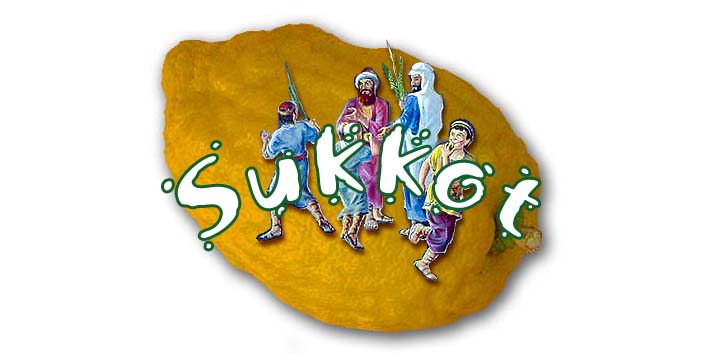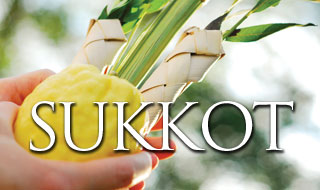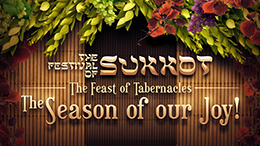The Feast of Sukkot is commonly known in English as “The Feast of Booths” or “Tabernacles.” The Hebrew word “סוכות” – “sukkot” is the plural form of the word “סוכה” – “sukkah,” which simply means a tabernacle, a booth, or a temporary shelter.
The Feast of Sukkot is first and foremost a festival of rejoicing (Lev. 23:40 & Deut. 16:14-15). God commanded His children to rejoice before Him during these days of Sukkot:
Now on the first day you shall take for yourselves the foliage of beautiful trees, palm branches and boughs of leafy trees and willows of the brook, and you shall rejoice before the LORD your God for seven days. You shall thus celebrate it as a feast to the LORD for seven days in the year. It shall be a perpetual statute throughout your generations; you shall celebrate it in the seventh month. – Lev. 23:40-41
The Feast of Sukkot is commonly known as the “Feast of Feasts” on the Jewish calendar. It is a feast of pure joy and celebration in keeping with God’s Word.
What is the true “Joy” of Sukkot?
God gave the children of Israel extremely clear instructions regarding how to celebrate this festival in the book of Leviticus (Lev. 23:33-44):
- Celebrate the Feast of the LORD for seven days, after bringing in the harvest, with a day of rest on the first and eighth days. To read more about the “Eighth Day,” click this link: The Eighth Day
- Offer daily offerings by fire on the altar.
- Live in booths (“סוכות” – “sukkot” in Hebrew) during these days and remember the Exodus when God had the Israelites live in booths after they came out of Egypt. (see below for more specifics about the “sukkah”)
- Take four different kinds of tree branches and rejoice before the LORD.
The Four Species of tree branches, as interpreted today, are as follows:
- The Etrog (a citrus fruit)
- Lulav (a palm branch)
- Hadas (a myrtle branch)
- Arava (a willow branch)
According to Jewish practice, the four species are waved in six directions; north, south, east, west, up, and down. This is to symbolize the sovereignty of God as King over the entire universe.
As with all of the Jewish festivals, there are elements that are directly from Scripture and elements that have been added and have become tradition. Although there are some in Christian circles who view Jewish traditions as non-essential, it is interesting to note how often Yeshua used Jewish tradition to speak of spiritual truths. We will see an illustration of this from the life of Yeshua at The Feast of Sukkot.
Hosha-na!
There is a special prayer during Sukkot called “Hosha-na,” which means “Please save!” or “Save us!” During the morning prayers of Sukkot this special additional prayer is recited in the synagogue. Four times the Hosha-na (“Hosanna” in English) prayer is uttered with a different focus each time:
-
Save us for Your sake, our God. Save us!
-
Save us for Your sake, our Creator. Save us!
-
Save us for Your sake, our Redeemer. Save us!
-
Save us for Your sake, our Benefactor (one who grants requests). Save us!
During each of the first six days of Sukkot special Hosha-na hymns are sung. Then on the seventh day we arrive at Hoshana Rabba – “The Great Salvation!”
On Hoshana Rabbah Jewish tradition teaches that this is the last opportunity to repent and have one’s sins atoned for. Hoshana Rabba is considered a special day, a gift from God to Abraham and to his children, a day of great forgiveness and salvation.
The Feast of Ingathering
The Feast of Sukkot is also called “חג האסיף” – Chag Ha’Asif, meaning The Feast of Ingathering. This is taken from the agricultural element that is connected to the season of this particular holiday:
You shall celebrate the Feast of Booths seven days after you have gathered in from your threshing floor and your wine vat; and you shall rejoice in your feast, you and your son and your daughter and your male and female servants and the Levite and the stranger and the orphan and the widow who are in your towns. Seven days you shall celebrate a feast to the LORD your God in the place which the LORD chooses, because the LORD your God will bless you in all your produce and in all the work of your hands, so that you will be altogether joyful. – Deut. 16:13-15
In connection to Rosh HaShanah (The Jewish New Year), which occurs two weeks before The Feast of Sukkot, the agricultural year is coming to an end and God gave the Jewish people a type of “Thanksgiving” holiday to mark the end of the ingathering of the harvest.
God wants His people to remember that He is their provider and that He is faithful to bless abundantly. God wants His people to stop and remember His faithfulness. God also wants His people to share in the abundance that they have received with the others around them. They are to rejoice in the abundance that God provides and give generously as He has been generous to them.
The Water of Sukkot
When the Temple stood in Jerusalem it was customary for the priests to draw water from a nearby stream and to pour this water on the altar during the Festival of Sukkot. There are two Hebrew phrases that accompany this practice of the drawing and pouring out of the water:
-
Simhat Beit Ha’sho’eiva – The celebration of drawing water
-
Nisuach Hamayim – The pouring out of water
What is the significance of the pouring out of water on the altar?
The Mishnah teaches that the world’s entire supply of water for the coming year is decreed during Sukkot. In keeping with this belief, it is the Jewish custom at the Festival of Sukkot to ask God for a year of abundance while water is poured out on the altar of the Temple in Jerusalem, during the days of a standing Temple. Today this water ceremony is replaced by joyous dancing during the festive evenings of Sukkot since there is no standing Temple in Jerusalem.
It is also believed that prophetic revelation is also drawn out during this water ceremony. “The chassidic masters explain that the water celebration signifies a joy caused by a connection to G‑d so deep and so true that, like water, it has no describable taste. And like water, it sustains all life.” (Menachem Posner, Chabad.org)
Today Psalms 120-134 are recited and sung during the nights of Sukkot and between each Psalm, Isaiah 12:3 is recited: “You shall draw water in joy from the springs of salvation (ישועה – yeshua).”
Did Yeshua tap into this tradition?
As we consider all of these Jewish traditions combined with biblical practices and commands it is sometimes challenging to know if and how to integrate all of these various teachings into our faith today with the New Covenant of Yeshua as our foundation. Thankfully, Yeshua provides us with the following interpretation regarding these details:
Now on the last day, the great day of the feast, Yeshua stood and cried out, saying, “If anyone is thirsty, let him come to Me and drink. He who believes in Me, as the Scripture said, ‘From his innermost being will flow rivers of living water.’” But this He spoke of the Spirit, whom those who believed in Him were to receive; for the Spirit was not yet given, because Yeshua was not yet glorified. – John 7:37-39
This was during the Feast of Sukkot (John 7:2). Yeshua offered a spiritual source of water (the Holy Spirit) that would flow from within a person, rivers of living water, for those who would believe in Him. Yeshua was telling everyone that He alone is the source of the “springs of salvation” spoken of in Isaiah 12:3. The word for salvation in this verse is the Hebrew word ישועה – Yeshua. Yeshua was saying that He is the source of water. Yeshua was declaring that He is the source of salvation. Yeshua was saying that He is God!
Restoring the Fallen Tabernacle of David
One final tradition that is part of the Sukkot celebrations is a prayer that is added to “Grace after the Meals” during the holiday of Sukkot. The traditional blessing recited after meals includes the phrase: “May the Merciful One raise up for us the fallen sukkah of David.” This added phrase to the prayer is taken from the Scripture found in the book of the prophet Amos:
“In that day I will raise up the fallen booth (Sukkah) of David,
And wall up its breaches;
I will also raise up its ruins
And rebuild it as in the days of old;
That they may possess the remnant of Edom
And all the nations who are called by My name,”
Declares the LORD who does this. – Amos 9:11-12
What does it mean for God to “…raise up the fallen booth (Sukkah) of David…”? There are many different understandings of this, including the focus of many Christians today to restore the worship and praise that David established during his reign as king. I believe that restored worship is part of the promise of God, however, it is clear from the context of these verses along with their being quoted in the New Testament (Acts 15:13-18 ) that the restoration of the fallen booth (tabernacle) of David is referring to believing Gentiles together with believing Jews worshiping the Messiah, Yeshua.
We also read in the prophet Zechariah that all nations will one day celebrate The Feast of Sukkot when Yeshua comes to reign as the Messiah (Zechariah 14:16). To read more about the prophetic significance of the biblical feasts, I recommend the following article: The Appointed Times & the Messiah
The Reason for Our Joy
The Feast of Sukkot is a yearly reminder for all of us to stop, to remember God’s faithfulness to provide for all of our needs, and to return our gratitude to the Creator of the universe. We celebrate with family and friends, Jew and Gentile alike, and call upon the LORD as our source of Salvation, “ישוע” – “Yeshua!” Yeshua is the true source of joy during our celebration of Sukkot!
Sukkot Sameach! (Happy Sukkot!)
If you enjoyed reading this article, share it today with friends! We also invite you to sign up for our weekly Torah Portion commentary on the sidebar to the right.
Help keep our weekly commentaries free and available to all. Click here to donate today:
First day of Sukkot – Sept. 21, 2021 (begins on the evening of Monday, Sept. 20)
Torah Reading: Lev. 22:26 – Lev.23:44 & Num. 29:12-16
Haftarah Reading: Zech. 14:1-21 & Ecclesiastes
Return to Torah Portion Homepage
Extra tidbits about Sukkot:
The requirements for the Sukkah (booth)
- At least two walls and a roof made of plant material.
- Cannot be erected under a tree or any other structure.
- It must be open to the elements, sun by day and stars by night.
- It should be decorated.
- Customary to decorate the Sukkah with the Seven species of the Land
- Major commandment is to sleep in it.
- Required to eat all meals in the Sukkah during sukkot
- Seven Ushpizin who visit the Sukkah during Sukkot: Abraham, Isaac, Jacob, Joseph, Moses, Aaron, and David – each wandered in one way or another.
- We must also invite other guests (real people) – Deut. 16:14
Hoshana Rabba – It is tradition to stay up all night on the night of Hoshana Rabba and read the entire books of Deuteronomy and Psalms.
Copyright Jewels of Judaism All rights reserved 2021






Daniel, this teaching is so clearly written and reminds to celebrate with such joy , anticipating Yeshua’s return ! In the meantime we again are reminded that He is our Provider in every way in our lives. Praise Him!
Thanks Venessa! Yes, there are many good reminders in Sukkot to strengthen our faith!
MAY MOSHIACH COME SPEEDILY IN OUR DAYS, TO BRING FULL REDEMPTION TO OUR PEOPLE AND TO THE WORLD, AND OUR TEMPLE WILL BE REBUILT.
How blessed and joyful I am to have read this teaching so beautifully set out! Love this teaching! HOSHA-NA! Emma
Dear Emma, Thank you for your comments! God bless you!
Daniel